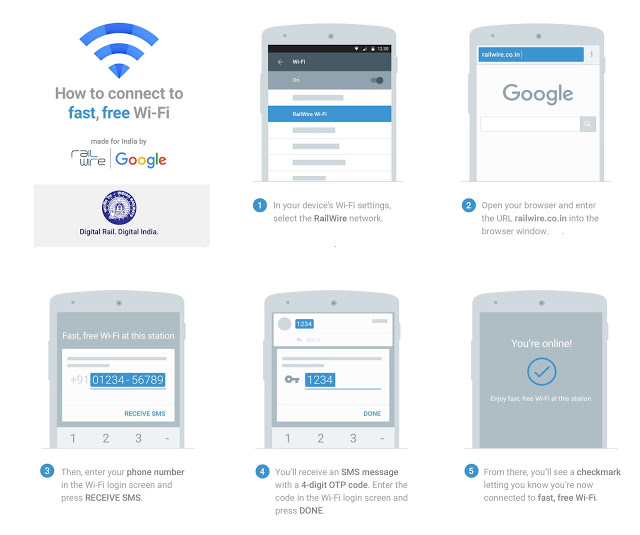India has emerged as the second largest internet user base after China accounting 413 million internet users and a considerable amount of new internet users turning up every month. With such mammoth opportunities, the technological honchos like Facebook, Google and Microsoft are striving in every possible way to get maximum profit and at the same time aiding Indians with better services, products and connectivity. Lack of public Wi-Fi, poor and expensive internet quality by telecom operators lured these technological predators.
Google started its initiative by partnering with Railtel (Railways Telecom Wing) which offers free Wi-Fi to Mumbai train commuters. Google will, subsequently, expand its reach by installing free Wi-Fi in cities of Allahabad, Patna, Ranchi and Jaipur in its next phase.
Google is targeting 100 busiest railway stations in India in its first phase and the remaining 300 stations will get the connectivity in the second phase. Google’s Wi-Fi router’s reach scale is quite wide compared to the existing Wi-Fi at some of the stations like Bengaluru and Pune. For the first hour, users will experience a commendable speed that will slow down with the following hour.
The experience of some Wi-Fi users in Mumbai’s Central Station was overwhelming. Commuters used the Wi-Fi for many reasons: ranging from casually surfing the internet to getting valuable information about the trains.
Google Free WiFi: Why Indian Railways First
Indian railways are one of the largest transport networks in the world with over 12,000 trains carrying 23 million passengers per day and connecting about 8,000 stations and a cumulative route of 65,000 Km. Hence, free Wi-Fi on railway stations seems to be an impressive idea as railway stations in India can be considered a hub for passengers coming from various parts of the country.
Secondly, the rising number of smartphone users in India, currently peaking at 204.1 million, India is reported to surpass the US this year. Whereas there are still 1 billion people in India that are devoid of the internet and hold a huge market potential. The arrival of cheap and better phones has transformed the Indian society as everyone ranging from a fruit vendor to a business magnate now flaunts a smartphone.
The rising numbers of unique internet users are highlighting the fact that Indians are gradually becoming aware of the Internet and its usefulness. The word ‘Free’ is an alluring catch as Indians are always in search of the products that are free, be it a free soap with detergent or a free Wi-Fi.
Observing all facts we can conclude that the Free Wi-Fi initiative by Google is welcomed by Indians. And sooner we may see the number of mobile internet users in India sky-rocketing with the launch of cheaper and better versions of smartphones. The idea of installing the Wi-Fi only on the busiest stations by altruistic Google can be regarded as one of the wisest ideas to connect the individuals, as a number of people who do not have access to the internet use the railway Stations regularly.
Yes, It’s A Free Lunch, But Healthy For Both
Apart from the rising number of smartphone users in India and the increasing awareness of the usefulness of the Internet, there is another far more overwhelming fact for Google. India is the fastest growing economy among the BRIC nations with a prediction of growth figure close to 7.8 % in 2016. And according to Softbank’s CEO Masayoshi Son, India may become the largest economy in the world in the coming 25-30 years.
The initiative by Facebook of Free basics was backlashed due to its incompatibility with net-neutrality. Google will be taking wiser steps to pierce through the Indian market after surveying the failure of Free Basics. We say that nothing is better than providing free Wi-Fi to Indians and Google has done just that winning the hearts of Indians.
But what’s in it for Google? Why is Google committed to offering free lunch to millions of Indian who travel by train every day? These few questions that still loom large on the face, but when we dig deep, it looks like a master stroke by Google. A vast amount of Google’s revenue comprises of online advertisements is directly proportional to the amount of traffic. Thus, the number of new users the better for Google, as using the Wi-Fi most number of users prefer watching the videos on YouTube and searching the internet using Goggle search, which will indirectly lead to Google’s traffic increase. The cost of installation and providing the internet can also be catered indirectly.
We conclude believing that this collaboration can be considered mutually beneficial for Google as well as for India, as the internet is the hub of knowledge and connectivity with the world. A vast number of Indians are devoid of Internet and hence, Public Wi-Fi may be the solution. We find Google’s initiative commendable and the first working model in Mumbai is welcomed by commuters.


